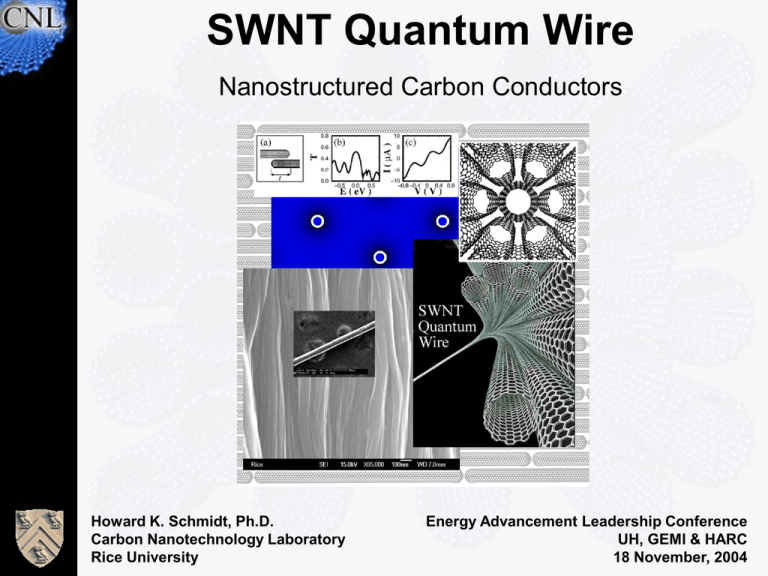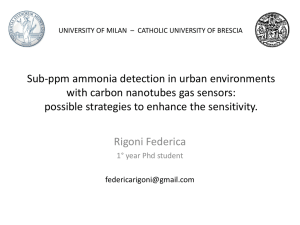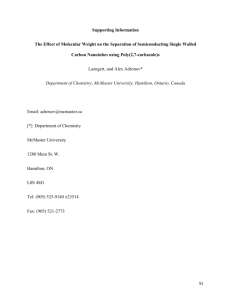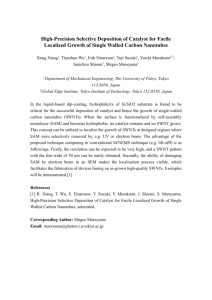Howard K Schmidt
advertisement

SWNT Quantum Wire Nanostructured Carbon Conductors Howard K. Schmidt, Ph.D. Carbon Nanotechnology Laboratory Rice University Energy Advancement Leadership Conference UH, GEMI & HARC 18 November, 2004 Carbon Nanotechnology Laboratory “Making Buckytubes “Be All They Can Be” Launched 2003 as a division of CNST Focuses SWNT Research of 10 Faculty in 6 Departments Prof. Richard E. Smalley - Director Dr. Howard K. Schmidt - Executive Director Dr. Robert H. Hauge - Technology Director Why SWNT? MOLECULAR PERFECTION & EXTREME PROPERTIES • • • • • The Strongest Fiber Possible Thermal Conductivity of Diamond The Unique Chemistry of Carbon The Scale and Perfection of DNA Selectable Electrical Properties • Metallics Better Than Copper • Semiconductors Better Than InSb or GaAs • The Ultimate Engineering Material Some SWNT Applications Graphics Source: NASA SWNT Quantum Wire Expected Features • 1-10x Copper Conductivity • 6x Less Mass • Stronger Than Steel • Zero Thermal Expansion Key Grid Benefits • Reduced Power Loss • Low-to-No Sag • Reduced Mass • Higher Power Density SWNT Technology Benefits • Type & Class Specific • Higher Purity • Lower Cost • Polymer Dispersible SWNT Tensile Strength Predicted tensile strength of single-wall nanotubes >100 GPa Calculated strain-tofailure >30% Measurements on small bundles found strength over 60 GPa Yakobson, et al., Comp. Mat. Sci. 8, 341 (1997). Conductivity of Metallic SWNT • Measurements on individual metallic SWNT on Si wafers with patterned metal contacts • Single tubes can pass 20 uA for hours • Equivalent to roughly a billion amps per square centimeter! • Conductivity measured twice that of copper • Ballistic conduction at low fields with mean free path of 1.4 microns • Similar results reported by many • Despite chemical contaminants and asymmetric environment Dekker, Smalley, Nature, 386, 474-477 (1997). McEuen, et al, Phys.Rev.Lett.84, 6082 Quantum Tunneling Alper Buldum and Jian Ping Lu, Phys. Rev. B 63, 161403 R (2001). Tunneling Evidence • Indirect indication of conductivity by measuring lifetimes of photoexcited electrons • Cooling mechanism is interaction with phonons – just like electrical resistivity • Anomalously long life-times yield mean free path of 15 microns (10x single tubes) • Based on bundles in ‘buckypapers’ – good local symmetry and clean, but still based on mixture of metals and semi-conductors • Results imply 10 – 25x better conductivity than copper Source: Tobias Hertl, et al, Phys. Rev. Lett. 84(21) (2000) 5002 Getting The Right Tubes • Need Single Type of Metallic SWNT • Current Growth Inadequate – Mixtures of ~ 50 Types – Mixtures of Metals, Semi-Metals & Semiconductors – Impure & Inefficient • N,M Control Critical – – – – Quantum Wire Electronics & Sensors Biomedical Therapeutics Energy Conversion Storage • Seeded Growth Required – – – – Separates Nucleation From Growth Eliminate By-Products & Purification Vastly Improved Efficiency Sort Once at Small Scale Rolling Graphite - n,m Vectors Chiral angle 0,0 1,0 2,0 1,1 3,0 1,1 4,0 3,1 2,2 Zigzag 5,0 4,1 3,2 5,1 4,2 3,3 7,0 6,0 6,1 5,2 7,1 6,2 4,3 5,3 4,4 Ar mc 8,0 ir 8,1 7,2 6,3 5,4 ha 9,0 9,1 8,2 7,3 6,4 5,5 10,0 10,1 9,2 8,3 7,4 6,5 12,0 11,1 10,2 9,3 8,4 7,5 6,6 11,0 10,3 8,5 7,6 11,3 9,6 8,7 11,5 10,6 9,7 8,8 12,3 11,4 10,5 9,5 13,1 12,2 10,4 8,6 7,7 12,1 11,2 9,4 13,0 10,7 9,8 SWNT Excitation Fluorescence Excitation wavelength (nm) [vn cn transition] Each peak comes from a specific semi-conducting SWNT n,m value 900 0.3000 0.2323 0.1798 0.1392 0.1078 0.08348 0.06463 0.05004 0.03875 0.03000 0.02323 0.01798 0.01392 0.01078 0.008348 0.006463 0.005004 0.003875 0.003000 800 700 600 500 400 300 900 1000 1100 1200 1300 1400 Emission wavelength (nm) [c1v1 transition] 1500 SWNT Seeded Growth Current Results 1. Attach Catalyst 2. Deposit on Inert Surface Key Starting Materials • Have FeMoC Catalyst • Have Short SWNT Seeds • Have Soluble SWNT Key Process Steps • In-Solution Attachment • Controlled Deposition • Catalyst Docking • Reductive Etching • Growth is Next !! 4. SWNT Growth 3. “Dock” Catalyst SWNTamp Production Concept Hydro-carbon feedstocks SWNT+ FeMoC Catalyst Seeded Growth 500 < T < 700 C Mono-Type SWNT (1000 lb / day ) Bulk Output “Inner Loop” Processing Seed Preparation. (1 lb/ day) Cut SWNT, Prep. Catalyst, Functionalize, Attach, Dock Production Scale-Up Path • Rice made 1 mg / day in 1997 • Lab-scale reactor at 1 gm / hour (2002) • CNI Pilot plant producing 20 lb /day • CNI now testing 100 lb / day reactor Forming SWNT Wires • Need macro-crystalline SWNT fiber/wire • Starting material is tangled at several scales • Starting material has variety of diameters and types • Enormous Van der Waals forces make it hard to separate SWNT bundles 50 mm Dispersion in Super-Acids • SWNT bundles swell in superacids • Dispersion due to “protonation” & intercalation of SWNTs in 102% H2SO4 “Spaghetti” In Oleum V. A. Davis et. Al., Macromolecues 37, 154 (2004) dried SWNT fiber W.-F Hwang and Y. Wang Cross section Prototype Wire - SWNT Fibers Current Oleum Spinning Results • Producing Neat SWNT Fibers • Dry-Spun from Oleum • 6 to 14 Wt. % SWNT Dope • Extruded as 50 µm Dia. Fibers • 109 Tubes in Cross Section • 100 Meters Long • Working On Alignment & Density Quantum Wire on The Grid Key Grid Benefits • Eliminate Thermal Failures • Reduce Wasted Power • Reduce Urban R.O.W. Costs • Enable Remote Generation Our Overloaded Grid The U. S. electric grid has become more unstable since 1998, with more failures that affect large populations of customers than the previous 50 years would predict Sources: DOE, Roger Anderson & Amin, IEEE Computer Applications in Power, 2001 US Power Production Map Currently, power is generated close to population centers Source: DOE & Nate Lewis, Caltech Renewable Resource Maps Renewable sources generally remote from major population centers Source: NREL Solar Base-Load Power Also for: • • • • • • Nathan S. Lewis, CalTech Nukes Hydro Wind Space Lunar ?? 3 TW 20 TW Grid Applications & Benefits • Eliminate Thermal-Sag Failure: Now a $100B+ a year problem. • Short-Distance AC: AQW could increase throughput up to ten-fold without increasing losses while using only existing towers and rights-of-way. Avoid new construction in congested urban areas – estimated over $100M per mile. • Medium-Distance AC: AQW could decrease resistive losses and voltage drop ten-fold if amperage were not increased. This would improve grid dynamics significantly in the range between 100 and 300 miles, where voltage stability limits deliverable power. • Long-Distance HVDC: AQW could permit amperage throughput ten fold or reduce losses ten-fold. New conventional lines cost $1M to $2M per mile, plus about $250M per AC/DC converter station. • Remote Power: Could enable utilization of large-scale renewables and remote nuclear. The Terawatt Challenge 50 50 45 40 35 30 25 20 15 10 5 0 2003 2050 45 40 14 Terawatts 30 -- 60 Terawatts 450 – 900 MBOE/day 35 210 M BOE/day 30 25 20 15 10 0.5% 5 20st Century = OIL 21st Century = ?? al eo ar ,w in d ,g Hy d ro el th ec t er m ric s m as Bi o n io n /F i ss io Ga s Fu s l Co a Oi l The Basis of Prosperity: Energy So l Source: Internatinal Energy Agency Bi om as H s So yd ro la r, el ec w in tri d, c ge ot he rm al io n Fi ss as G Co al O il 0 ENERGY for 1010 people • The biggest single challenge for the next few decades • At MINIMUM, we need 10 Terawatts (150 M BOE/day) from some new clean energy source by 2050 • For worldwide peace and prosperity we need it to be cheap. • We simply can not do this with current technology. • We need Boys and Girls to enter Physical Science and Engineering as they did after Sputnik. • Inspire in them a sense of MISSION ( BE A SCIENTIST - SAVE THE WORLD ) • We need a bold new APOLLO PROGRAM to find the NEW ENERGY TECHNOLOGY Help Wanted ! PhD Degrees in Science and Engineering 25000 Asians citizens All fields of Science & Engineering PhD per year 20000 15000 US citizens, all fields of Science and Engineering, (excluding psychology & social sciences) 10000 US citizens, Physical Sciences and Engineering only 5000 0 1985 1990 1995 2000 2005 Year Source: Science and Engineering Indicators, National Science Board, 2002





